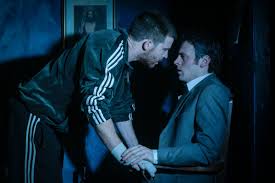Q44 Theatre, Richmond
Reviewed on November 8, 2016

In several short years, Melbourne’s Q44 Theatre has established and solidified a reputation as the go – to outlet for quality chamber drama.
This season alone, the company earned strong critical praise for ‘Sister Cities’ (by Colette Freedman) and ‘Sex With Strangers’ (by Laura Eason). Their third and final production for 2016 is ‘Shining City’ by Conor McPherson.
Born in Ireland, McPherson is an award winning playwright, screen writer and director. Works for the stage include Rum and Vodka (1992), The Good Thief (1994), The Weir (1997), Dublin Carol (2000), Port Authority (2001) and The Night Alive (2013).
Told in a single act, ‘Shining City’, covers vast emotional territory in its compact, ninety – minute running time. Betrayal, guilt and regret are just some of the powerful themes on offer.
John is a widower who lost his wife in a devastating taxi accident. He is using therapy as a means to help cope with her death. His therapist, Ian, is struggling with some personal demons as well. A former priest who abandoned his faith, Ian has since fallen into a relationship which has left him feeling both trapped and confused.
During the course of their sessions together, John makes several startling admissions. These claims not only become part of his eventual healing process, they also impact and influence Ian in ways the therapist daren’t imagine.
Noted productions ran on London’s West End at the Royal Court Theatre (2004) and on Broadway at the Biltmore Theatre (2006). Based in New York City, The Irish Repertory Theatre presented the play earlier this year Off – Broadway as well. With direction by Ciaran O’Reilly, that limited engagement featured Matthew Broderick, Ian Carter, Lisa Dwan, and James Russell.
Memorable plays and motion pictures that have used therapy as a central theme or crucial plot – point include ‘Suddenly Last Summer’, ‘Ordinary People’, ’Beyond Therapy’, ’Truly. Madly. Deeply.’, ’Antonia & Jane’, ‘The Sixth Sense’, and ‘The Humans’.
The common links between these pieces were intimacy and seclusion. Both traits have been duplicated and built upon within Q44 Theatre’s four walls.
Gabriella Rose – Carter directs her team of four performers with a sensitive and deft touch. In her care, she also brings McPherson’s flawed yet personable characters to heartbreaking life. Rose – Carter’s group understand the value of acting, listening and reacting, creating an atmosphere of natural yet heightened emotion. (Will Atkinson must also be credited for his assistant direction).
Being at such close range to the cast, allows viewers the luxury of seeing them work head on. By playing inward and rarely to the audience, establishes a necessary isolation and separation contained in McPherson’s choice of words. In creating this direct pathway, the quartet often communicate some of the more – quiet moments simply with their eyes.
Sebastian Gunner brings to John, desperate yet measured physicality. By adding this specificity as he slowly unwinds, reinforces the character’s progress on the road to redemption.
As Neasa, Madeline Claire French presents a twelve – step range of raw emotions in her short yet confronting scene. As a spurned partner struggling to know the truth, from playing anger to defeat, French is utterly convincing in this dismissal.
Nick Cain brings blue collar pride to Laurence. A man forced to make difficult choices to keep his family afloat, Cain fleshes out his character with gentle pain and awkward humour.
Anthony Scundi gives a career – defining performance as Ian. His grasp of McPherson’s spare and precise dialogue, enrich both the character and our connection to him. In order to make a new life for himself, Scundi shows us a man prepared to risk everything.
As the actors speak with soft Irish accents, Suzanne Heywood’s solid vocal coaching gives the play an extra edge of authenticity.
Masterful set design is by Casey – Scott Corless. With construction by John Byrne, together, they have reworked the venue’s interior in ways which must be seen in person to be fully appreciated. Creating a mood which compliments and adds to the story, Ian’s office in fact rests on the second storey of a multi – tiered layout. The use of platforms gives each character position and placement. Whenever the actors switch places by stepping up or down, their hierarchical rank also shifts within the confined space, too.
Expert lighting design is by John Collopy. He adds linear detail, and when both John and Ian are closer to recovery, the implementation of warmer tones lifts and propels the piece with new hope.
Through the use of musical interludes and cue points, Justin Gardam’s sound design also enriches each character’s individual journey. (It should be noted that lighting and sound operation are by Will Prescot and Meg Spencer, with set and costume assistance by Annalisa Lucca).
Clothing also establishes and outlines these players, an unspoken class system and their state of mind. Ian wears smart casual, while Neasa and Lawrence are in ill – fitting tracksuits. John has the greatest arc, progressing from tired jeans to a business suit by the play’s conclusion.
Small production choices like an omnipotent portrait of Jesus, Ian page turning a calendar or John tidying his hair, are the little elements which add to the overall effect of marking time and place. Fluid and precise stage management from Atkinson allow ebb and flow where necessary.
Without giving anything away, McPherson includes an ending which packs quite a punch. In fact, the recent Off – Broadway production in New York City set theatre internet forums and fan boards a flutter as a result. This lyrical, spiritual and poetic experience will stay in mind long after the final bows are taken.
‘Shining City’ runs until November 27.
Image Source: Q44 Theatre
